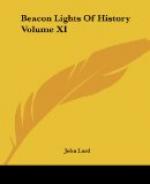But a new career was opened to Franklin with the attainment of leisure and independence,—the career of a scientific investigator. The subject which most interested him was electricity, just then exciting great interest in Europe. In 1746 he attended in Boston a lecture on electricity by Dr. Spence, of Scotland, which induced him to make experiments himself, the result of which was to demonstrate to his mind the identity of the electrical current with lightning. What the new, mysterious power was, of course he could not tell, nor could any one else. All he knew was that sparks, under certain conditions, were emitted from clothing, furs, amber, jet, glass, sealing-wax, and other substances when excited by friction, and that the power thus producing the electric sparks would repel and attract. That amber, when rubbed, possesses the property of attracting and repelling light bodies was known to Thales and Pliny, and subsequent philosophers discovered that other substances also were capable of electrical excitation. In process of time Otto Guericke added to these simple discoveries that of electric light, still further established by Isaac Newton, with his glass globe. A Dutch philosopher at Leyden, having observed that excited electrics soon lost their electricity in the open air, especially when the air was full of moisture, conceived the idea that the electricity of bodies might be retained by surrounding them with bodies which did not conduct it; and in 1745 the Leyden jar was invented, which led to the knowledge that the force of electricity could be extended through an indefinite circuit. The French savants conveyed the electric current through a circuit of twelve thousand feet.
It belonged to Franklin, however, to raise the knowledge of electricity to the dignity of a science. By a series of experiments, extending from 1747 to 1760, he established the fact that electricity is not created by friction, but merely collected from its state of diffusion through other matter to which it has been attracted. He showed further that all the phenomena produced by electricity had their counterparts in lightning. As it was obvious that thunder clouds contained an immense quantity of the electrical element, he devised a means to draw it from the clouds by rods erected on elevated buildings. As this was not sufficiently demonstrative he succeeded at length in drawing the lightning from the clouds by means of a kite and silken string, so as to ignite spirits and other combustible substances by an electric spark similar to those from a Leyden jar. To utilize his discovery of the identity of lightning with electricity he erected lightning-rods to protect buildings, that is, to convey the lightning from the overhanging clouds through conductors to the ground. The importance of these lightning-rods was doubtless exaggerated. It is now thought by high scientific authorities that tall trees around a house are safer conductors in a thunder storm than




